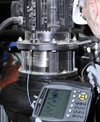

Businesses are always looking for ways to reduce their costs and enhance their competitive edge. One of the areas being addressed is unscheduled maintenance, which can be a major contributor to operating costs.
Machine breakdowns and the resulting downtime often prevent companies from operating at maximum productivity, limiting profitability and competitiveness. To address this problem, SKF has developed a new work management processes, called asset efficiency optimisation (AEO). This programme is designed to enable industrial organisations to achieve significant increases in their productivity as quickly and efficiently as possible, and with minimum investment.
To draw up a maintenance strategy that is both efficient and effective, thorough planning is vital. Maintenance managers and engineers need to ask the right people the right questions to draw useful and accurate conclusions that can be built upon. Doing this properly can seem impossible with daily operational challenges and time constraints; however, by using a structured needs analysis programme, the most beneficial improvement opportunities can be clearly identified.
Identifying problems
Before implementing any integrated reliability and risk-based asset management strategy, a company must first gain an accurate understanding of where they are currently in terms of asset efficiency, and where they need to be to attain optimum performance.
The SKF client needs analysis service enables this understanding to be reached effectively by providing useful, actionable information to help companies focus on the most credible opportunities available.
The information gathered by the client needs analysis is aligned with the AEO work flow model and will help clients achieve optimum performance from their maintenance effort by identifying opportunities and gaps in their current practices.
The data gathered during the assessment helps SKF to provide a snapshot of the plant’s current situation; the answers also take into account the maturity of its approach to maintenance, ranging from a wholly reactive situation to a truly proactive strategy. Combining the answers to the questions with information on industry specific aspects of maintenance and reliability a unique needs-based analysis can be created.
Structured approach to assessments so that key personnel have a clear picture of the maintenance processes currently in place and the improvements that are necessary, the information gathered should be compiled in a clear and organised format that can be easily digested and distributed. A comprehensive report on the current situation along with the client’s own goals and priorities will lead to the establishing of a detailed roadmap of change required to achieve optimum performance from the maintenance department.
With SKF’s client needs analysis, companies are provided with a report that details a micro-level assessment for the questions answered in the analysis, a macro-level assessment for the four main aspects of the asset efficiency optimisation process, a ranked deviation chart, and a detailed roadmap for improving plant reliability. The process also uses a dynamic industry specific benchmark that is updated with each new case, allowing the client to compare themselves with similar industries across the globe.
Targeting areas for improvement
The most necessary and viable areas for improvement can be found by assessing performance indicators against these benchmarks in each of the four areas covered by the AEO programme: maintenance strategy, work identification, work control, and work execution. In relation to the maintenance strategy, it is important to have accurate information about maintenance budget, asset replacement value and current plant availability; as well as understanding how maintenance tasks are selected vs asset criticality.
So that the maintenance strategy can be implemented effectively, detailed information must also be collected on the other three aspects of AEO. For example, work identification related information should include the work order processes and priorities that are being followed, the skills and competencies of operators, and the preventive and predictive maintenance techniques employed. This information can enable better identification of potential faults before they become a problem, decreasing unplanned downtime and increasing production efficiency.
For more information contact Samantha Joubert, SKF South Africa, +27 (0)11 821 3500, [email protected], www.skf.co.za
| Tel: | +27 11 821 3500 |
| Fax: | +27 11 821 3501 |
| Email: | [email protected] |
| www: | www.skf.co.za |
| Articles: | More information and articles about SKF South Africa |

© Technews Publishing (Pty) Ltd | All Rights Reserved